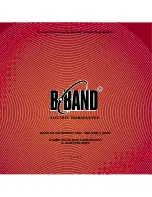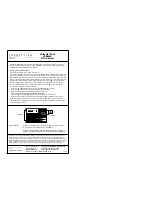
SECTION I
GENERAL INFORMATION
1.1
INTRODUCTION
This Model 460 Digital STL Transmitter User’s Guide is arranged in eight sections, as follows:
Section I: General Information
A general description of the DIGITAL Transmitter, its specifications, general information on the FCC designator, warranty
and damage claim procedures, and technical support information.
Section II Getting To Know Your Model 460 and Related Equipment
Overview of the various system components of the DIGITAL Transmitter and related equipment. Control and Indicator
functions, basic component functions, and their interconnection.
Section III: Pre-Installation Checkout
Some basic test methodology on the DIGITAL Transmitter and its related equipment. The user should find it useful to perform
the tests in this section with all the DIGITAL Transmitter equipment on a lab bench.
Section IV: Programming The DIGITAL
Transmitter
Detailed description of setup procedures of various DIGITAL Transmitter system parameters, as well as enabling of optional
features.
Section V: Installation
Instruction for installing and adjusting various system components of the DIGITAL Transmitter.
Section VI: Theory of Operation
TBD.
Section VIII: Theory of Operation
Basic description of I/O control circuits.
Section VIII: Maintenance and Repair
Describes routine maintenance procedures and tools and equipment requirements.
1.2 EQUIPMENT
DESCRIPTION
The DIGITAL Transmitter is part of a combined Digital Studio to Transmitter Link that provides broadcasters with six
uncompressed program channels and a data channel to meet the requirements of consolidated operations. It provides the
maximum number of high quality program channels over a single RF channel.
The TFT Digital STL consists of a transmitter and receiver pair that accommodates up to three AES/EBU (stereo) inputs
or up to six discrete audio channels. The transmitter has a 2-Watt output and delivers them uncompressed in a
configurable digital method to the receiver. Sample rates of 32, 44.1, and 48 ks/s are supported. The method of
modulation is a function of the number of channels and sample rate and is configurable from a front panel jack that can
be connected to a laptop PC. The RF system is frequency agile and set by software in the transmitter and receiver.
The frequency and input/output configuration of both the transmitter and receiver can be set for optimum values of
threshold and modulation via a laptop PC that can be connected to a modem. User-friendly software with a graphical
user interface (GUI) is provided with each system. The transmitter and receiver can be remotely controlled over an
internet or LAN connection.
1.3
SPECIFICATIONS
The DIGITAL Transmitter performance and physical specifications are listed in Table 1.3-1.
1-1





















